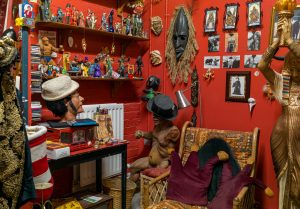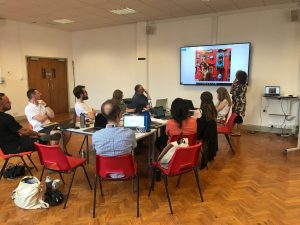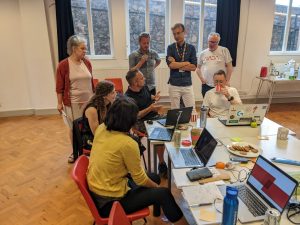When Ian’s Smith archive was donated to the Theatre Collection (TC) in 2020, it arrived with laser scans of his studio captured in 2018-19. Ian’s studio was much more than a place of work. It was like an artwork in itself that reflected Ian’s practices and artistic concerns, the interior including Ian’s collections of books, LPs, model toys and furniture, all carefully arranged and displayed. Ian died in 2014, but it had felt important to create a record of this space to put with his archive.

It was the first accession at the TC to include these types of digital files and it really started us thinking about 3D data and asking questions about how we preserve and facilitate access to these files. Since then, we have also started to 3D capture objects within our collections, raising even more questions and queries about the data produced at the point of capture.
Thanks to The National Archives Archive Testbed Fund, we held a three day event using the ‘book sprint’ format to explore some of the questions that we have surrounding 3D data capture and preservation, using Ian’s studio as our case study. The idea of a ‘book sprint’ is to produce a collaborative piece of writing in a short period of time and in our case, we wanted to produce a basic in-house guidance document (Starting with 3D Data) that would help us develop principles, workflows and procedures for managing 3D data. We wanted to share this guidance with the wider archive community, as we hope it will provide a starting point for non-specialised archive services, who, like us at the TC, are meeting the challenges of managing 3D data for the first time.
We gathered a group of people together to take part with a variety of different expertise and experience in 3D data capture and preservation including:
- Sam Brenton, Digital Archives Assistant, University of Bristol
- Malcolm Brown, Deputy Photographer, Cultural Heritage Digitisation Service, University of Edinburgh (created the 3D scans of Ian Smith’s studio in a freelance capacity)
- Sarah Bustamante-Brauning, Digitisation Officer, University of Bristol Theatre Collection
- Catherine Dack, Research Support Librarian, University of Bristol
- Angie Dight, Director and Co-founder of Mischief La-Bas, wife of the artist Ian Smith whose studio was scanned in 3D
- Stephen Gray, Head of Research Support, Library Services University of Bristol
- Emma Hancox, Digital Archivist, University of Bristol
- Kieron Niven, Digital Archivist, Archaeology Data Service, University of York
- Sean Rippington, Digital Archives and Copyright Manager, University of St Andrews
- Julian Warren, Keeper: Digital and Live Art Archives University of Bristol Theatre Collection
- Sian Williams, Project Archivist: Ian Smith Archive, University of Bristol Theatre Collection
This blog focuses on the three key discussion areas we addressed each of the three days of the sprint that helped us develop our 3D data guidance document, Starting with 3D Data.
Day 1: Data Creation
As Ian’s studio was our case study, we asked Angie to introduce us to his studio and guide us around the space with the photographs that were captured by Malcolm in 2018-19.

Ian Smith (1959-2014) was an artist, performer and artistic director, founding the acclaimed Glasgow-based performance company, Mischief La-Bas, with his wife, Angie in 1992. As Angie explained, Ian, as a child of the 1950s and influenced by his older brother, loved 50s pop culture, was captivated by David Bowie and saw no divide between high art and low art. His studio, ‘The Den’ was his thinking and ideas place, and it really encapsulated his eclectic collecting and creativity. His artistic creations, known as ‘Pulptures’, described by Ian as ‘like sculptures but not as good’ adorn the walls and models of characters from film and TV, including his own bastardised creations, line the shelves.
Ian’s studio became the springboard for our all discussions, but in terms of data creation it helped us to address the fundamental questions:
Why capture in 3D? In terms of Ian’s studio, it was part of the WASP Artist Collective of studio spaces in Glasgow, so it would not have been possible to preserve his studio in situ in perpetuity. As described by Malcolm, the studio was like “stepping inside someone’s head”, as it really captured Ian’s personality and creativity. As Malcolm recognised at the time, there was a compelling case for not only capturing the space in 2D, but also to experiment with 3D capture. Although 2D can capture detail, laser scanning presents the possibility of capturing the space as a whole, its scale and relationships between objects.
As with Ian’s studio, Malcolm recognised the value of capturing the studio in 3D, but it was agreed there should always be a criteria for 3D capture. In terms of preservation, there is limited argument for scanning robust objects. Items should be prioritised for scanning based on a preservation need i.e. objects made inherently of material that degrades quickly and therefore require minimal handling or spaces/objects which may no longer exist. At the TC we hold many set models, which were only ever made with the intention of being temporary. The models are particularly vulnerable to damage with multiple and often fragile moving parts, but are high-use objects by researchers and teaching groups. In these cases, there is a clear need to 3D capture and create a digital surrogate, as 3D models can be manipulated in ways the original set model cannot be due to risk of damage.
How do you capture 3D? Ian’s studio was captured by LiDAR or laser scanning, which uses light waves to calculate distance and is often used for larger spaces. We explored other methods of 3D capture including photogrammetry, structured light and a hybrid version of both, as well as the challenges of each and different considerations depending on the method of capture, including cost implications and equipment requirements.
Day 2: File Formats and Metadata
To ascertain what file formats we should be requesting at the point of deposit and what metadata should be captured and recorded, we heard from those in the group with experience of 3D capture, so we could understand the process in more detail. Using worked examples, we looked at photogrammetry with 3D models of objects including set models. We explored the challenges at point of capture i.e. difficulties with using a green screen and white objects on white background, what files to keep (DNG, TIFF) and creating a mesh to produce a 3D model.

Ian’s studio was LiDAR scanned to experiment capturing the space beyond 2D, but it was not processed at the time into a usable 3D model. In terms of future deposits, it would be more likely that the depositor would produce a 3D model as the final product, as this would be the primary aim of capturing the space/object. We are currently experimenting with the files of Ian’s studio to see if we can produce a workable model, and you can see how far we’ve got on Sketchfab.
What file formats and metadata should we have asked for at the point of deposit? In archival terms, we want to preserve the raw data with minimal intervention at the point of capture. But as our discussions highlighted, there is difficulty in this with 3D capture in terms of what is considered the raw data, as there is a lot of process involved in capturing and creating usable models. In order to access the data it requires a process to create a model by creating a mesh. This often requires the use of proprietary software. We would therefore want to ask the depositor for their raw files (whatever they might consider that to be), as well as an access copy of the finished 3D model that the depositor is happy with i.e. a meshed OBJ file.
In terms of metadata, it was helpful to hear about the Archaeology Data Service, and what we can learn from archaeologists, who regularly capture 3D data. The Archaeology Data Service already has a set of principles in terms of what metadata is requested from the depositor, which will help to develop our own set of principles. We started to consider what questions we should have asked for at the point of deposit of Ian’s studio scans, such as:
- Reason for capture and additional context
- What type of device was used
- What software was used
- Copyright holder information i.e. person who has made the decisions in the scanning process, as well as the objects that are included in the scans
- Image of the equipment setup and colour capture
- Accurate measurements of the space/object
- Location where scan taken
- Number of points of capture
- Capture date
- How many scans within the model
- How the files are structured and arranged
Day 3: Audiences and Access
With such innovative potential for 3D data, we discussed our audiences and how we could make the 3D data accessible to them.
Currently the TC is introducing the digital preservation platform, Preservica, but due to early development and lack of demand for a 3D viewer on the platform, its viewer remains fairly rudimentary at the moment. We therefore discussed the need to use a temporary platform to access the 3D models in the meantime. However, in using these platforms such as Sketchfab and 3DHOP, there are of course cost implications, as well as considerations with ownership and licensing in addition to the increased amount of time and resources required for the processing to produce accessible 3D models. Using these platforms could potentially drive more traffic to our catalogue, but in using multiple platforms to making our digital models accessible this way we would need to ensure that the relationship with the catalogue is maintained. As always with archives, we are thinking about the future and whether these platforms will exist or be usable in the long term, reinforcing the archival reasons for preserving the raw data.
These discussions that took place over the book sprint event have fed into our guidance document for the TC. We will use this document as a reference point as we start to build our procedures and workflows for dealing with 3D data. Just as Ian’s studio encouraged us to start exploring 3D data, we hope our guidance document may be a useful starting point for any non-specialised archive service looking to explore 3D data capture and preservation.
